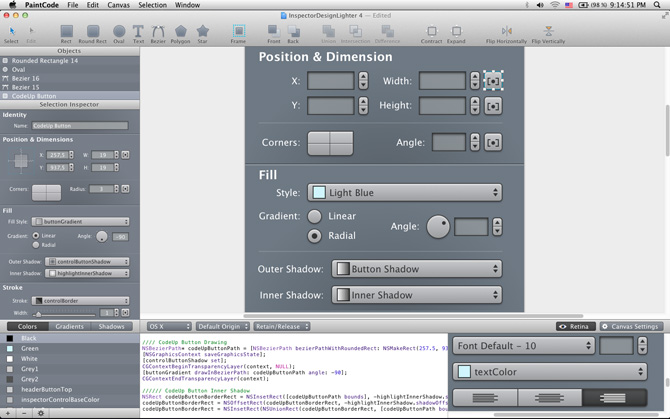

The source code it generates can easily calculate the scale of everything it does at runtime. Reproducing a single graphic at different sizes is simple in PaintCode. PaintCode solves all of this and goes further still. Some apps even offer multiple themes or colour schemes. So this seems like the ultimate solution to avoid producing multiple versions of your single graphic, right? What about if your app has a dark mode? You’d need to provide two versions of each graphic, one in each colour scheme. The latest version of Xcode allows the vector data to be retained so they can be rendered as the app runs. Initially, Xcode would rasterise these at build time, so their use was somewhat limited.
PAINTCODE IOS PDF
Recent versions of Xcode have offered the ability to use PDF files containing vector artwork as graphics within applications. But rather than predetermining all the required sizes, and burdening your app with all those image files, wouldn’t it be great if you could generate any required size on the fly in your app? These cover different devices as well as different uses like the home screen, notifications, and Settings screen.Ī vector-based design program is desirable, otherwise, you’d have to design your graphic at the largest size and then hope it would scale down well to the required smaller sizes, as well as hoping you’d never need a bigger one in the future. While a simple button icon should likely always be the same size, what if the size of your graphic does need to change depending on the device it is displayed on, say iPhone versus iPad, or the orientation of the device? What about all the different sizes introduced by the iPad’s multitasking split views? Even beyond device attributes, what if you want to use the same graphic at multiple sizes within your app even on a single device? You can imagine the total number of sizes required can balloon quickly.Īs an aside to illustrate this point, although PaintCode cannot solve this particular problem, an iOS app icon has 15 different sizes.

While it is not likely we’ll see quad-density displays any time soon, there is another aspect to consider.
PAINTCODE IOS PLUS
The Plus iPhones, along with the iPhone X, use a Super Retina display with triple the original density so even more pixels, and versions, are needed.

The iPhone 4 came along with a Retina display that doubled pixel density, meaning those same icons needed 40 or 60-pixel square images, as well as the original sizes. On early iPhones, a button icon was typically 20 or 30 pixels square depending on where it was used. Historically, if you wanted a button in your app that, say, had a clock icon on it, you would draw the icon in a graphics program and export an image which would be included in your app. I will focus on iOS from here on in, but most of what I say will apply to macOS, perhaps in different measure. You might wonder why this is a desirable thing. What PaintCode does that no other tool does is produce code that, when executed, will recreate your designs by drawing the same shapes. PaintCode can export images of your designs, but if that’s all you’re wanting to do, there are better and more capable tools, such as Affinity Designer. Once you have your designs, the final output is not what you’d expect from most design tools.

You can use colours, gradients and transparency, change fills and strokes, choose fonts, and transform and manipulate everything to your heart’s content. You have canvases on which you can draw rectangles, circles, polygons, Bézier curves, and text. PaintCode looks like many other vector illustration apps. Its output, however, is program source code. It is, without question, a graphic design tool. For this reason, I have aimed this review at a less knowledgeable audience, which should also serve to explain to hobbyist developers, like myself, what value this tool can bring.Įven more specific than PaintCode’s audience is the basic principle of its operation. If you’re not a developer then this review may not offer you an insight into purchasing, however, if you’re just interested in knowing “how stuff works,” this is a pretty cool story. PaintCode is a macOS app with a very specific audience: macOS and iOS developers, although other developers should hang in until the end. In true NosillaCast fashion, there is a problem to be solved, but that will become apparent as the story unfolds. What follows will be a review for some and a propeller-beanie story for others.


 0 kommentar(er)
0 kommentar(er)
